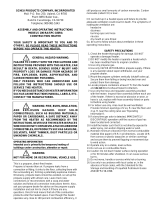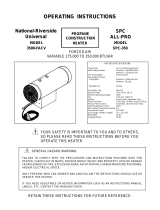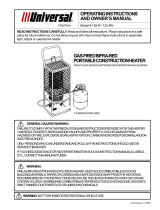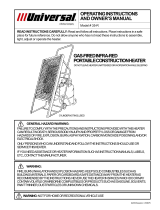
YOUR SAFETY IS IMPORTANT TO YOU AND TO OTHERS,
SO PLEASE READ THESE INSTRUCTIONS BEFORE YOU
OPERATE THIS HEATER.
!
Model
35-FAC/SPC-35
35,000 BTU/HR
! GENERAL HAZARD WARNING:
FAILURE TO COMPLY WITH THE PRECAUTIONS AND INSTRUCTIONS PROVIDED WITH THIS
HEATER, CAN RESULT IN DEATH, SERIOUS BODILY INJURY AND PROPERTY LOSS OR DAMAGE
FROM HAZARDS OF FIRE, EXPLOSION, BURN, ASPHYXIATION, CARBON MONOXIDE POISONING,
AND/OR ELECTRICAL SHOCK.
ONLY PERSONS WHO CAN UNDERSTAND AND FOLLOW THE INSTRUCTIONS SHOULD USE OR
SERVICE THIS HEATER.
IF YOU NEED ASSISTANCE OR HEATER INFORMATION SUCH AS AN INSTRUCTIONS MANUAL,
LABELS, ETC. CONTACT THE MANUFACTURER.
WARNING: FIRE, BURN, INHALATION, AND EXPLOSION HAZARD. KEEP SOLID COMBUS-
TIBLES, SUCH AS BUILDING MATERIALS, PAPER OR CARDBOARD, A SAFE DISTANCE AWAY FROM
THE HEATER AS RECOMMENDED BY THE INSTRUCTIONS NEVER USE THE HEATER IN SPACES
WHICH DO OR MAY CONTAIN VOLATILE OR AIRBORNE COMBUSTIBLES, OR PRODUCTS SUCH AS
GASOLINE, SOLVENTS, PAINT THINNER, DUST PARTICLES OR UNKNOWN CHEMICALS.
!
OPERATING INSTRUCTIONS
FORCED AIR PROPANE CONSTRUCTION HEATERS
SCHEU PRODUCTS COMPANY, INCORPORATED
MAIL: P.O. BOX 250, UPLAND, CA 91785
PLANT: 8855 BAKER AVE., RANCHO CUCAMONGA, CA 91730
TELEPHONE: 909-981-5343
HEATER SPECIFICATION
Type of Gas For Use with Propane Only
Gas Supply Pressure
to Regulator Max: 200 psi
Min: 20 psi
Regulator out 10 psi
Electrical Input 115V, 60 Hz 10, 3a
Minimum Operating Voltage 100V
Ignition Manual, Piezo Ignition
Primary Flame Control Thermocouple Operated Gas Valve
High Temperature Control 240
o
F
Min. Ambient Temp. Rating 0
o
F
Rating: 35,000 BTU/hr
Fuel Consumption: 1.6 #/hr
Fuel Orifice: .75 mm
Heated Air Output:
CFM: 100
Average Air Temp Rise: 150
o
F

RETAIN THESE INSTRUCTIONS FOR FUTURE REFERENCE.
OPERATING PRECAUTIONS
This is a propane, direct-fired, forced air heater. It's intended
use is primarily temporary heating of buildings under construc-
tion, alteration or repair.
WARNING
NOT FOR HOME OR RECREATIONAL VEHICLE USE
Propane is heavier than air. If propane leaks from a connection
or fitting, it sinks to the floor, collecting there with the surround-
ing air, forming a potentially explosive mixture. Obviously,
propane leaks should be avoided, so set up the propane supply
with utmost care. Leak check new connections or reconnections
with a soap and water solution and follow all connection
instructions herein. Also, ask your propane dealer for advice
on the propane application and supply installation and ask him
to check it if there are any questions.
Direct-Fired means that all of the combustion products enter
the heated space. Even though this heater operates very
close to 100 percent combustion efficiency, it still produces
small amounts of carbon monoxide. Carbon monoxide (called
CO) is toxic. We can tolerate small amounts but not a lot. CO
can build up in a heated space and failure to provide adequate
ventilation could result in death. The symptoms of inadequate
ventilation are:
headache
dizziness
burning eyes and nose
nausea
dry mouth or sore throat
So, be sure to follow advice about ventilation in these operating
instructions.
Forced Air means that a blower or fan pushes the air through
the heater. Proper combustion depends upon this air flow;
therefore, the heater must not be revised, modified or oper-
ated with parts removed or missing. Likewise, safety systems
must not be circumvented or modified in order to operate the
heater.
When the heater is to be operated in the presence of other
people the user is responsible for properly acquainting
those present with the safety precautions and instruc-
tions, and of the hazards involved.
SAFETY PRECAUTIONS
1. Check the heater thoroughly for damage. DO NOT
operate a damaged heater.
2. DO NOT modify the heater or operate a heater which
has been modified from its original condition.
3. Use only propane gas.
4. Use only VAPOR WITHDRAWAL propane supply. If
there is any question about vapor withdrawal, ask
your propane dealer.
5. Mount the propane cylinders vertically (shutoff valve
up). Secure them from falling or being knocked over
and protect them from damage.
6. Locate propane containers at least 7 ft. from the
heater and do not direct exhaust toward containers.
7. Use only the hose and regulator assembly provided
with the heater. Inspect hose assembly before each
use of the heater. If there is excessive abrasion or
wear, or hose is cut, replace with hose assembly
listed on parts list before using heater.
8. For indoor use only. Area must be well ventilated.
Provide minimum openings of 1/2 sq. ft. near the floor
and 1/2 sq. ft. near the ceiling (also see "Operating
Precautions").
9. If at any time gas odor is detected, IMMEDIATELY
DISCONTINUE operation until the source of gas has
been located and corrected.
10. Install the heater such that is is not directly exposed
to water spray, rain and/or dripping water.
11. Maintain minimum clearance from normal combust-
ible material (like paper) as follows:
floor-0 ft.;outlet-6 ft.; sides-2 ft.; top-6 ft. Locate 10 ft.
from canvas or plastic tarpaulins or similar coverings
and secure them to prevent flapping or movement
due to wind action.
12. Operate only on a stable, level surface.
13. Do not use with ductwork. Do not restrict inlet or exit.
14. Use only the electrical power specified. The electrical
connection and grounding must comply with National
Electrical Code - ANSI/NFPA 70.
15. Use only a properly grounded 3-prong receptacle or
extension cord (6 ft length-minimum).
16. Do not move, handle or service while hot or burning.
17. Use only in accordance with local codes or, in the
absence of local codes, with the Standard for the
Storage and Handling of Liquefied Petroleum Gases
ANSI/NFPA 58-1998.
35,000 BTU/HR
Page 2

PROPANE FUEL PRECAUTIONS
OPERATING INSTRUCTIONS
WARNING:
Local codes for installation of propane systems may vary consid-
erably. Therefore, ask your local propane supplier for advice on
propane system installation in your particular area. In the
absence of local codes, install in accordance with American
National Standards Institute (ANSI)/National Fire Protection
Association (NFPA) publication Standard for the Storage and
Handling of Liquefied Petroleum Gases ANSI/NFPA 58-1998.
Your supplier, fire marshal or library should have a copy.
The propane supply system must be arranged for vapor with-
drawal. Propane cylinders must be secured in the upright
position to keep them from falling or being knocked over.
During use, liquid propane in a container vaporizes. As it
vaporizes, the propane cools itself. If this cooling process
continues long enough and proceeds fast enough, the propane
temperature and pressure will fall so low that heater operation
may be improper or even impossible even though plenty of
propane remains in the container. Often frost forms on the
outside of the propane container as a warning of excessive
refrigeration.
PREPARING FOR OPERATION
1. Check the heater for possible shipping damage. If
any is found, immediately notify your dealer.
2. Follow all of the "Precautions" on pages 2 & 3.
3. Connect the POL fitting of hose and regulator assem-
bly to the propane cylinder by rotating the POL nut
counterclockwise into the propane cylinder's valve
outlet and securely tighten with a wrench.
4. Connect the hose to the heater by rotating the hose
fitting clockwise.
5. Securely tighten all gas connections.
6. Open the cylinder's gas valve and check all gas
connections with a soap and water solution. DO NOT
USE A FLAME.
7. Connect extension cord to well-grounded 115V, 60Hz,
10 source of power. Heater fan will operate.
8. When using an extension cord, make certain that it is
a 3-wire (grounded) cord of proper wire size.
START
1. Before heater ignition always allow heater fan to run
20 seconds to purge fuel.
2. Open propane supply valve on propane tank(s) slowly.
Note: If not opened slowly, excess-flow check valve on
propane tank will stop gas flow. If this happens close
propane supply valve and open again slowly.
3. Push in and hold automatic control valve button. Push
piezo ignitor button repeatedly until the burner lights.
4. After the burner lights keep the gas valve button
depressed for 30 seconds then release and the
heater will continue to operate.
WARNING: Be sure motor and fan are running before
pushing in automatic control valve button. Flames
could flash outside heater if motor and fan are not
running.
STOP
1. Securely close valve on the propane cylinder.
2. Continue to operate heater until all fuel in the hose
has burned.
3. Unplug the power cord.
NOTICE: Always shut off fuel supply before disconnecting
electrical power.
RESTART AFTER SAFETY SHUTDOWN
1. Securely close valve at propane cylinder. Unplug
heater.
2. Wait 5 minutes.
3. Restart following "Start" procedure.
MAINTENANCE AND STORAGE
1. The heater should be inspected before each use, and
at least annually by a qualified person.
2. Before each use, check the soft "O" ring seat at the
bullnose of the POL fitting. If the "O" ring is cut,
scuffed, or otherwise damaged, replace it with part
number 6681.
3. Turn off the gas at the LP-gas supply cylinder(s) when
the heater is not in use.
4. When the heater is to be stored indoors, the connec-
tion between the LP-gas supply cylinder(s) and the
heater must be disconnected and the cylinder(s)
removed from the heater and stored out of doors and
in accordance with Chapter 5 of the standard for
Storage and Handling of Liquefied Petroleum Gases
ANSI/NFPA 58-1998.
NOTE:
See page 4 for size and capacity of propane cylinders
required.
Recommendations to reduce the ill effects of refrigeration are:
* Provide considerably more propane than you plan to
consume. As a rule of thumb, provide twice as much.
* Fill containers frequently, especially in cold weather.
Never allow propane to fall below one-third of container
capacity.
* If possible, keep containers in a warm area. Under no
circumstances should the heater exhaust be directed toward
the propane container.
* Watch for frost formation on the container. If it occurs,
discontinue use of the heater and refill the container.
Page 3
35,000 BTU/HR

SERVICING
A hazardous condition may result if a heater is used that has
been modified or is not functioning properly. When the heater
is working properly:
* The flame is contained within the heater.
* The flame is essentially blue with perhaps
some yellow tipping.
* There is no strong disagreeable odor, eye
burning or other physical discomfort.
* There is no smoke or soot internal or external to
the heater.
* There are no unplanned or unexplained shut
downs of the heater.
The parts lists and wiring diagram show the heater as it was
constructed. Do not use a heater which is different from that
shown. In this regard, use only the hose, regulator and
cylinder connection fitting (called a POL fitting) supplied with
the heater. Do not use alternates. For this heater, the
regulator must be set as shown on "specifications". If there
is any uncertainty about the regulator setting, have it checked.
A heater which is not working right must be repaired, but only
by a trained, experienced service person. Contact the
factory for the service center closest to you, phone number
(909) 981-5343.
You may also obtain in-warranty or out-of-warranty service
by returning the product freight prepaid to:
Scheu Products Company
8855 Baker Avenue
Rancho Cucamonga, CA 91730
In-warranty products returned to the Service Department will
be repaired with no charge for either parts or labor and will be
returned to you freight prepaid. Please include a brief
statement indicating date, place of purchase, the nature of
the problem and proof of purchase.
Out-of-warrranty products returned to the Service Depart-
ment will be repaired with a charge for parts and labor and will
be returned to you freight collect.
35,000 BTU/HR
AIR TEMPERATURE -
o
F
MAXIMUM OPERATING TIME - HOURS
SIZE AND CAPACITY OF PROPANE
CYLINDERS REQUIRED
The charts below show the approximate size of the cylinder
required for these heaters. To use the chart:
1. Select the lowest air temperature expected (at the
bottom of the chart).
2. Move straight up to time of operation desired (left
side of chart).
3. Read the cylinder size required.
P/N 8097C
September 2000
Page 4
ANSI Z83.7b-1993/CGA 2.14-1972

Item SPC-35
No. Part No. Description Qty.
1 10720 Heater Body Kit 1
2 2100 Control Box Assy 1
3 8079 Valve w/Thermocouple 1
* 1007 Hose & Regulator Assembly 1
*
*
7 8080 Electrode 1
8 6168 High Limit Switch 240
o
F1
*
10 8091 Nut Hex M8 x 1 Fine Thd Thermocouple 2
11 8076 Motor 0.74 A 1
12 2101 Grille Assembly 1
Item SPC-35
No. Part No. Description Qty.
SPC-35
* Not shown on exploded view
8098B
September 2001
13 8077 Fan Blade, 6.75 x .75 Pitch 1
14 2113 Power Cord Assembly 1
15 8136 Bushing Strain Relief, .25 1
16 6503 Nut Hex 5-28 TE Valve 2
17 7161 Nut, Piezo 1
18 6473 Piezo Ignitor 1
19 7094 Clip Handle 2
20 7095 Handle 1
* 8092 Label, Model Warnings 1
* 8093 Label, Operating Instructions 1
* 8097 Manual, Operating Instructions 1
* 8098 Parts List/Wiring Diagram 1
INSTRUCTIONS FOR ORDERING PARTS
All parts orders must show heater Model No., Item No., Part
No. and Description. We recommend that only parts supplied
by the manufacturer be used on this unit. A locally purchased
part may appear to be identical, although in reality it might
endanger the heater or the persons operating the heater.
The heater should be serviced only by a trained, experi-
enced service person.
Read the section on "Servicing" before ordering parts.
For parts order, call (909) 981-5343.
-
 1
1
-
 2
2
-
 3
3
-
 4
4
-
 5
5
Desa SPC-35 Owner's manual
- Type
- Owner's manual
- This manual is also suitable for
Ask a question and I''ll find the answer in the document
Finding information in a document is now easier with AI
Related papers
-
 Scheu Products Company 100-RA (1990+) Owner's manual
Scheu Products Company 100-RA (1990+) Owner's manual
-
Universal Remote Control SPC-150T User manual
-
Desa Tech 25-VC Owner's manual
-
Desa Tech 44-PH Owner's manual
-
 Scheu Products Company 3500-FACV Owner's manual
Scheu Products Company 3500-FACV Owner's manual
-
 Universal SPC125-R User manual
Universal SPC125-R User manual
-
Desa Tech 80-VCNG Owner's manual
-
Desa Tech SPC-500 Owner's manual
-
Desa Tech 7000-FACV Owner's manual
-
 Universal 35-R User manual
Universal 35-R User manual
Other documents
-
Ryobi P2180 Owner's manual
-
Enerco MH35FA User manual
-
Enerco Electric Heater HS35FA User manual
-
Power Fist 8677460 Owner's manual
-
Enerco HeatStar HS35FA User manual
-
Power Fist 8677486 Owner's manual
-
 Universal 125-RN User manual
Universal 125-RN User manual
-
Mr. Heater HS35FA Operating instructions
-
Enerco MH80CV User manual
-
Enerco HS80CV User manual









